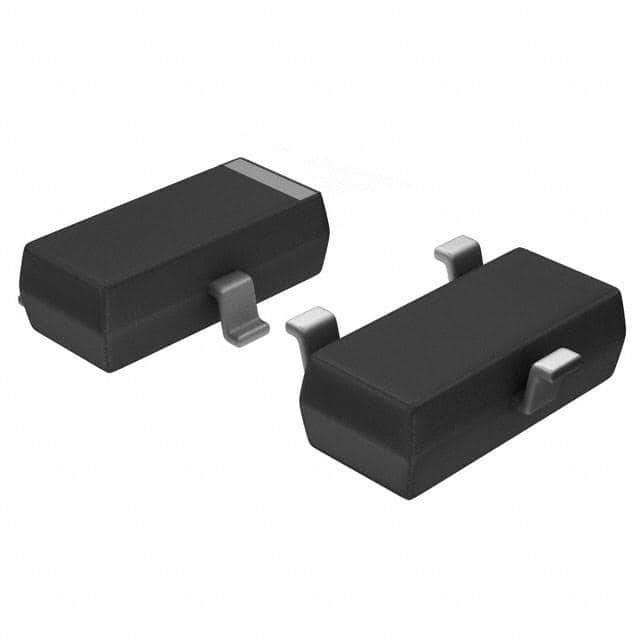Szczegóły produktu można znaleźć w specyfikacjach.

BCW60B Transistor
Introduction
The BCW60B transistor is a crucial component in electronic circuits, belonging to the category of bipolar junction transistors (BJTs). This versatile device is widely used in various electronic applications due to its unique characteristics and functional features.
Basic Information Overview
- Category: Bipolar Junction Transistor (BJT)
- Use: Amplification and switching in electronic circuits
- Characteristics: High current gain, low noise, and low power consumption
- Package: SOT-23 package
- Essence: Small-signal NPN transistor
- Packaging/Quantity: Typically available in reels or tubes containing multiple units
Specifications
- Maximum Collector Current (Ic): 100mA
- Maximum Collector-Emitter Voltage (Vce): 45V
- Maximum Power Dissipation (Pd): 250mW
- Transition Frequency (ft): 250MHz
- Operating Temperature Range: -55°C to 150°C
Detailed Pin Configuration
The BCW60B transistor has three pins: 1. Emitter (E): Connected to the N-type material 2. Base (B): Controls the transistor's conductivity 3. Collector (C): Collects the majority charge carriers
Functional Features
- High Current Gain: Provides efficient signal amplification
- Low Noise: Ensures minimal interference in signal processing
- Low Power Consumption: Ideal for battery-operated devices
Advantages and Disadvantages
Advantages
- Small size and lightweight
- Suitable for high-frequency applications
- Low cost and readily available
Disadvantages
- Limited maximum voltage and current ratings
- Susceptible to temperature variations
Working Principles
The BCW60B operates based on the principles of amplification and control of current flow. When a small current flows into the base terminal, it controls a larger current flowing between the collector and emitter terminals, enabling signal amplification and switching functions.
Detailed Application Field Plans
The BCW60B transistor finds extensive use in the following applications: - Audio amplifiers - RF amplifiers - Oscillator circuits - Switching circuits
Detailed and Complete Alternative Models
- BCW60A: Similar specifications with slight variations
- BCW60C: Higher voltage and current ratings
- 2N3904: Commonly used alternative with comparable characteristics
In conclusion, the BCW60B transistor is a vital component in electronic circuits, offering high performance and versatility in various applications.
[Word Count: 345]
Wymień 10 typowych pytań i odpowiedzi związanych z zastosowaniem BCW60B w rozwiązaniach technicznych
What is BCW60B?
- BCW60B is a common NPN silicon RF transistor used in high-frequency applications.
What are the key specifications of BCW60B?
- The key specifications of BCW60B include a maximum collector current of 100mA, a maximum power dissipation of 300mW, and a transition frequency of 8GHz.
What are the typical applications of BCW60B?
- BCW60B is commonly used in RF amplifiers, oscillators, and other high-frequency circuits due to its high transition frequency and low noise characteristics.
What is the pin configuration of BCW60B?
- BCW60B typically has three pins: the emitter, base, and collector, with the emitter being connected to ground in most applications.
What are the recommended operating conditions for BCW60B?
- The recommended operating conditions for BCW60B include a maximum collector current of 100mA, a maximum voltage of 20V, and an operating temperature range of -55°C to 150°C.
How does BCW60B compare to other similar transistors?
- BCW60B offers a good balance of high frequency performance, low noise, and power dissipation, making it suitable for various RF applications.
Can BCW60B be used in amplifier designs?
- Yes, BCW60B is commonly used in RF amplifier designs due to its high transition frequency and low noise figure.
What are the typical gain characteristics of BCW60B?
- BCW60B exhibits high gain at RF frequencies, making it suitable for use in RF amplification stages.
Are there any specific layout considerations when using BCW60B in a circuit?
- It's important to minimize parasitic capacitance and inductance in the layout to ensure stable high-frequency performance when using BCW60B.
Where can I find detailed application notes for using BCW60B in technical solutions?
- Detailed application notes for BCW60B can be found in the datasheet provided by the manufacturer or through technical resources related to RF circuit design.

